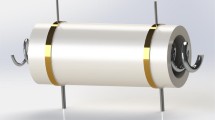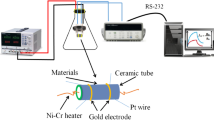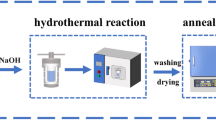Abstract
The goal of the current research was to develop CuO-ZnO heterojunction capable of detecting NO2 gas at room temperature. Pure CuO and CuO-ZnO composite samples were developed by changing the weight percentage of CuO and ZnO using a simple precipitation method and nominated as CZ0, CZ1, CZ2 and CZ3. Structural, optical and morphological properties of pristine CuO and heterojunctions were studied using XRD, FE-SEM, BET, XPS, FTIR and PL. Investigation of gas sensing properties revealed that the CZ2 sample (20 wt% ZnO) exhibited maximum response of 36.7% to 100 ppm of NO2 gas at room temperature. The mechanism behind the response of pristine material and CuO-ZnO was explained in detail. The development of p-n heterojunction due to the combination of p-type CuO and n-type ZnO was responsible for the increase in the gas detecting capabilities of the synthesized composite material for detecting NO2 gas at ambient temperature. Hence, the proposed approach focuses on the design of a cost-effective and sensitive gas sensor that can sense NO2 gas even at room temperature.















Similar content being viewed by others
Data availability
The datasets generated or analysed during the current study are available from the corresponding author upon reasonable request.
References
T.L. Guidotti, The higher oxides of nitrogen: inhalation toxicology. Environ. Res. 15(3), 443–472 (1978). https://doi.org/10.1016/0013-9351(78)90125-1
E. Oh et al., High-performance NO2 gas sensor based on ZnO nanorod grown by ultrasonic irradiation. Sens. Actuat. B Chem. 141(1), 239–243 (2009). https://doi.org/10.1016/j.snb.2009.06.031
A. Richters, K. Kuraitis, Inhalation of NO2 and blood borne cancer cell spread to the lungs. Arch. Environ. Heal. An Int. J. 36(1), 36–39 (1981). https://doi.org/10.1080/00039896.1981.10667604
R. Kumar, O. Al-Dossary, G. Kumar, A. Umar, Zinc oxide nanostructures for NO2 gas–sensor applications: a review. Nano-Micro Lett. 7, 97–120 (2015). https://doi.org/10.1007/s40820-014-0023-3
N. Barsan, C. Simion, T. Heine, S. Pokhrel, U. Weimar, Modeling of sensing and transduction for p-type semiconducting metal oxide based gas sensors. J. Electroceramics 25, 11–19 (2010). https://doi.org/10.1007/s10832-009-9583-x
D.R. Miller, S.A. Akbar, P.A. Morris, Nanoscale metal oxide-based heterojunctions for gas sensing: a review. Sens. Actuat. B Chem. 204, 250–272 (2014). https://doi.org/10.1016/j.snb.2014.07.074
A. Umar et al., Fabrication and characterization of CuO nanoplates based sensor device for ethanol gas sensing application. Chem. Phys. Lett. 763, 138204 (2021). https://doi.org/10.1016/j.cplett.2020.138204
C.S. Rout, K. Ganesh, A. Govindaraj, C.N.R. Rao, Sensors for the nitrogen oxides, NO2, NO and N2O, based on In2O3 and WO3 nanowires. Appl. Phys. A 85, 241–246 (2006). https://doi.org/10.1007/s00339-006-3707-9
B. Zhang et al., High-performance room temperature NO2 gas sensor based on visible light irradiated In2O3 nanowires. J. Alloys Compd. 867, 159076 (2021). https://doi.org/10.1016/j.jallcom.2021.159076
T. Zhou, T. Zhang, J. Deng, R. Zhang, Z. Lou, L. Wang, P-type Co3O4 nanomaterials-based gas sensor: preparation and acetone sensing performance. Sens. Actuat. B Chem. 242, 369–377 (2017). https://doi.org/10.1016/j.snb.2016.11.067
K.-H. Chen, J.-S. Niu, W.-C. Liu, Study of a new hydrogen gas sensor synthesized with a sputtered cerium oxide thin film and evaporated palladium nanoparticles. IEEE Trans. Electron Devices 68(8), 4077–4083 (2021). https://doi.org/10.1109/TED.2021.3093842
S. Lu et al., Sensitive H2 gas sensors based on SnO2 nanowires. Sens. Actuat. B Chem. 345, 130334 (2021). https://doi.org/10.1016/j.snb.2021.130334
T. Gao, T.H. Wang, Synthesis and properties of multipod-shaped ZnO nanorods for gas-sensor applications. Appl. Phys. A 80, 1451–1454 (2005). https://doi.org/10.1007/s00339-004-3075-2
H. Rahman, H. Dhoundiyal, A. Kumar, M.C. Bhatnagar, Fabrication and electrical surface characterization of pellets of V2O5 nanostructures for robust and portable gas sensor applications. Appl. Phys. A 129(4), 271 (2023). https://doi.org/10.1007/s00339-023-06554-9
C. Li, P.G. Choi, K. Kim, Y. Masuda, High performance acetone gas sensor based on ultrathin porous NiO nanosheet. Sens. Actuat. B Chem. 367, 132143 (2022). https://doi.org/10.1016/j.snb.2022.132143
X. Hu, Z. Zhu, C. Chen, T. Wen, X. Zhao, L. Xie, Highly sensitive H2S gas sensors based on Pd-doped CuO nanoflowers with low operating temperature. Sens. Actuat. B Chem. 253, 809–817 (2017). https://doi.org/10.1016/j.snb.2017.06.183
J. Zhang, H. Lu, C. Liu, C. Chen, X. Xin, Porous NiO–WO 3 heterojunction nanofibers fabricated by electrospinning with enhanced gas sensing properties. RSC Adv. 7(64), 40499–40509 (2017). https://doi.org/10.1039/C7RA07663K
N.M. Vuong, N.D. Chinh, Y.-I. Lee, CuO-decorated ZnO hierarchical nanostructures as efficient and established sensing materials for H2S gas sensors. Sci. Rep. 6(1), 1–13 (2016). https://doi.org/10.1038/srep26736
U.T. Nakate, Y.T. Yu, S. Park, High performance acetaldehyde gas sensor based on pn heterojunction interface of NiO nanosheets and WO3 nanorods. Sens. Actuat. B Chem. (2021). https://doi.org/10.1016/j.snb.2021.130264
Q. Cheng et al., Highly sensitive and fast response acetone gas sensor based on Co3O4–ZnO heterojunction assembled by porous nanoflowers. J. Mater. Sci. Mater. Electron. 34(2), 128 (2023). https://doi.org/10.1007/s10854-022-09566-y
Y. Wang et al., CuO/WO3 hollow microsphere PN heterojunction sensor for continuous cycle detection of H2S gas. Sens. Actuat. B Chem. 374, 132823 (2023). https://doi.org/10.1016/j.snb.2022.132823
A. Kumar, A. Sanger, A. Kumar, R. Chandra, Highly sensitive and selective CO gas sensor based on a hydrophobic SnO2/CuO bilayer. RSC Adv. 6(52), 47178–47184 (2016). https://doi.org/10.1039/C6RA06538D
D. Wu, Q. Zhang, and M. Tao, LSDA+ U study of cupric oxide: Electronic structure and native point defects. Phys. Rev. B., 73 (23) 235206 (2006). https://doi.org/10.1103/PhysRevB.73.235206
V.D. Patel, R. Dhar, N. Gandhi, S.R. Meher, D. Gupta, Solution-processed copper oxide thin film as efficient hole transport layer for organic solar cells. J. Electron. Mater. 51(2), 601–608 (2022). https://doi.org/10.1007/s11664-021-09313-9
D. Indhira et al., Biomimetic facile synthesis of zinc oxide and copper oxide nanoparticles from Elaeagnus indica for enhanced photocatalytic activity. Environ. Res. 212, 113323 (2022). https://doi.org/10.1016/j.envres.2022.113323
J. Singh, S. Lee, A. Tomar, J. Kim, A. Kumar Rai, Surfactant-mediated synthesis of novel mesoporous hollow CuO nanotubes as an anode material for lithium-ion battery application. ChemistrySelect 8(1), e202203755 (2023). https://doi.org/10.1002/slct.202203755
Y. Zhao, X. Zhou, W. Huang, J. Kang, G. He, High-performance copper nanowire electrode for efficient flexible organic light-emitting diode. Org. Electron. 113, 106690 (2023). https://doi.org/10.1016/j.orgel.2022.106690
A.M. Youssef, S.M. Yakout, High dielectric-energy storage and ferromagnetic-superparamagnetic properties: tetra-doping CuO nanocompositions. J. Mater. Sci. Mater. Electron. 34(2), 1–19 (2023). https://doi.org/10.1007/s10854-022-09564-0
Y. Xi, Z. Xiao, H. Lv, H. Sun, S. Zhai, Q. An, Construction of CuO/Cu-nanoflowers loaded on chitosan-derived porous carbon for high energy density supercapacitors. J. Colloid Interface Sci. 630, 525–534 (2023). https://doi.org/10.1016/j.jcis.2022.10.037
M. Gupta, H.F. Hawari, P. Kumar, Z.A. Burhanudin, Copper oxide/functionalized graphene hybrid nanostructures for room temperature gas sensing applications. Crystals 12(2), 264 (2022). https://doi.org/10.3390/cryst12020264
X. Li, Y. Shi, M. Wang, H. Wang, X. Shao, X. Sun, Ultra-sensitive TEA sensor based on bulk-like Zinc oxide nanostructures. J. Mater. Sci. Mater. Electron. 34(2), 140 (2023). https://doi.org/10.1007/s10854-022-09572-0
A. Rahnama, M. Gharagozlou, Preparation and properties of semiconductor CuO nanoparticles via a simple precipitation method at different reaction temperatures. Opt. Quantum Electron 44(6), 313–322 (2012). https://doi.org/10.1007/s11082-011-9540-1
M.P. Geetha, P. Pratheeksha, B.K. Subrahmanya, Development of functionalized CuO nanoparticles for enhancing the adsorption of methylene blue dye. Cogent Eng. 7(1), 1783102 (2020). https://doi.org/10.1080/23311916.2020.1783102
A. Thamer, A. Faisal, A. Abed, W. Khalef, Synthesis of gold-coated branched ZnO nanorods for gas sensor fabrication. J. Nanoparticle Res. 22(4), 74 (2020). https://doi.org/10.1007/s11051-020-04783-0
H. Zhu et al., A new strategy for the surface-free-energy-distribution induced selective growth and controlled formation of Cu2O-Au hierarchical heterostructures with a series of morphological evolutions. J. Mater. Chem. A 1(3), 919–929 (2013)
J. Das et al., Micro-Raman and XPS studies of pure ZnO ceramics. Phys. B Condens. Matter 405(10), 2492–2497 (2010)
X. Du, J. Huang, Y. Feng, Y. Ding, Flower− like 3D CuO microsphere acting as photocatalytic water oxidation catalyst. Chin. J. Catal. 37(1), 123–134 (2016)
S. Gunalan, R. Sivaraj, R. Venckatesh, Aloe barbadensis Miller mediated green synthesis of mono-disperse copper oxide nanoparticles: optical properties. Spectrochim. Acta Part A Mol. Biomol. Spectrosc. 97, 1140–1144 (2012). https://doi.org/10.1016/j.saa.2012.07.096
B. Toboonsung, P. Singjai, Formation of CuO nanorods and their bundles by an electrochemical dissolution and deposition process. J. Alloys Compd. 509(10), 4132–4137 (2011). https://doi.org/10.1016/j.jallcom.2010.12.180
P.S. Kumar, M. Selvakumar, S.G. Babu, S. Induja, S. Karuthapandian, CuO/ZnO nanorods: an affordable efficient pn heterojunction and morphology dependent photocatalytic activity against organic contaminants. J. Alloys Compd. 701, 562–573 (2017). https://doi.org/10.1016/j.jallcom.2017.01.126
S. Sihag, R. Dahiya, S. Rani, A. Jatrana, A. Kumar, V. Kumar, Investigation of structural and optical characteristics of CuO nanoparticles calcinated at various temperatures. Indian J. Chem. Technol. 29(5), 578–582 (2022). https://doi.org/10.56042/ijct.v2925.61511
K. Kannaki, P.S. Ramesh, D. Geetha, Hydrothermal synthesis of CuO nanostructure and their characterizations. Int. J. Sci. Eng. Res. 3(9), 1–4 (2012)
K. Chitra and G. Annadurai, “Antimicrobial activity of wet chemically engineered spherical shaped ZnO nanoparticles on food borne pathogen.,” Int. food Res. J., vol. 20, no. 1, 2013.
A. Fouda, S.S. Salem, A.R. Wassel, M.F. Hamza, T.I. Shaheen, Optimization of green biosynthesized visible light active CuO/ZnO nano-photocatalysts for the degradation of organic methylene blue dye. Heliyon 6(9), e04896 (2020). https://doi.org/10.1016/j.heliyon.2020.e04896
V. Kumar, A. Kumar, S.S. Priyanka, A. Jatrana, in In two-dimensional (2D) nanostructures for hazardous gas sensing applications. ed. by U. By Shanker et al. (Springer Nature, Switzerland, 2022). https://doi.org/10.1007/978-3-030-69023-6
M. Hübner, C.E. Simion, A. Tomescu-Stănoiu, S. Pokhrel, N. Bârsan, U. Weimar, Influence of humidity on CO sensing with p-type CuO thick film gas sensors. Sens. Actuat. B Chem. 153(2), 347–353 (2011). https://doi.org/10.1016/j.snb.2010.10.046
Y. Guo, M. Gong, Y. Li, Y. Liu, X. Dou, Sensitive, selective, and fast detection of ppb-level H2S gas boosted by ZnO-CuO mesocrystal. Nanoscale Res. Lett. 475(11), 1–9 (2016). https://doi.org/10.1186/s11671-016-1688-y
Y.B. Zhang, J. Yin, L. Li, L.X. Zhang, L.J. Bie, Enhanced ethanol gas-sensing properties of flower-like p-CuO/n-ZnO heterojunction nanorods. Sens. Actuat. B Chem. 202, 500–507 (2014). https://doi.org/10.1016/j.snb.2014.05.111
H. Fang, S. Li, H. Zhao, J. Deng, D. Wang, J. Li, Enhanced NO2 gas sensing performance by hierarchical CuO–Co3O4 spheres. Sens. Actuat. B Chem. 352(2), 131068 (2022). https://doi.org/10.1016/j.snb.2021.131068
T.-H. Han, S.-Y. Bak, S. Kim, S.H. Lee, Y.-J. Han, M. Yi, Decoration of CuO NWs gas sensor with ZnO NPs for improving NO2 sensing characteristics. Sensors 21(6), 2103 (2021). https://doi.org/10.3390/s21062103
S. Keerthana, K. Rathnakannan, Hierarchical ZnO/CuO nanostructures for room temperature detection of carbon dioxide. J. Alloys Compd. 897, 162988 (2022). https://doi.org/10.1016/j.jallcom.2021.162988
Acknowledgements
We are grateful to the IIC, IIT, Roorkee, Uttarakhand, for providing necessary ads for characterization tools.
Author information
Authors and Affiliations
Contributions
SS: conceptualization, methodology, formal analysis, investigation, data curation, writing—original draft, writing—review and editing, and visualization. RD, SR, PB, AJ: conceptualization, methodology, writing—review and editing and formal analysis. AK: methodology, validation, writing—review and editing. VK: original draft, writing—review and editing, supervision, formal analysis, investigation and visualization.
Corresponding author
Ethics declarations
Conflict of interest
The authors declare no conflict of interest.
Additional information
Publisher's Note
Springer Nature remains neutral with regard to jurisdictional claims in published maps and institutional affiliations.
Supplementary Information
Below is the link to the electronic supplementary material.
Rights and permissions
Springer Nature or its licensor (e.g. a society or other partner) holds exclusive rights to this article under a publishing agreement with the author(s) or other rightsholder(s); author self-archiving of the accepted manuscript version of this article is solely governed by the terms of such publishing agreement and applicable law.
About this article
Cite this article
Sihag, S., Dahiya, R., Rani, S. et al. The development of CuO-ZnO based heterojunction for detection of NO2 gas at room temperature. Appl. Phys. A 129, 717 (2023). https://doi.org/10.1007/s00339-023-06982-7
Received:
Accepted:
Published:
DOI: https://doi.org/10.1007/s00339-023-06982-7




